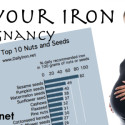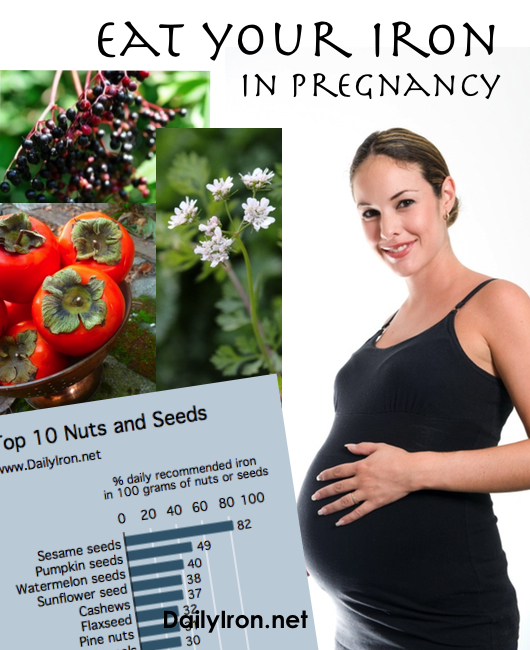 There are many options during pregnancy for consuming iron rich foods. The trick will be finding a combination that helps keep up your iron levels that you can palate at the same time. Pregnancy is notorious for food aversions that you have never experienced before and you will never experience again. Various meats (and their textures) are common aversions. If you can eat red meat in your pregnancy, it will be the best source of food iron for you. However, it may not otherwise be on your diet or you may not be able to palate it, making your task a little more complicated. Luckily there are many foods to choose from.
There are many options during pregnancy for consuming iron rich foods. The trick will be finding a combination that helps keep up your iron levels that you can palate at the same time. Pregnancy is notorious for food aversions that you have never experienced before and you will never experience again. Various meats (and their textures) are common aversions. If you can eat red meat in your pregnancy, it will be the best source of food iron for you. However, it may not otherwise be on your diet or you may not be able to palate it, making your task a little more complicated. Luckily there are many foods to choose from.
Meats
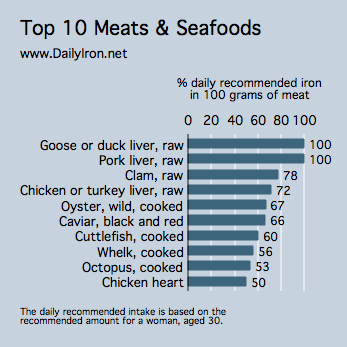 Meats are great sources of food iron because they tend to be high in iron (particularly red meat such as beef) but they also do not suffer from the iron inhibitors present in grains, beans, nuts, and seeds. Note that several types of animal liver top the list of iron foods and these same foods may be at the top of your “unpalatable” list during pregnancy. It happens to the best of us. However, you should also be cautious about liver in pregnancy. It is high in vitamin A and unless you have a known vitamin A deficiency, you probably do not want to consume too much. High levels of vitamin A during pregnancy can harm your growing baby. Luckily, there are many other meats to choose from. Read more about iron in meat.
Meats are great sources of food iron because they tend to be high in iron (particularly red meat such as beef) but they also do not suffer from the iron inhibitors present in grains, beans, nuts, and seeds. Note that several types of animal liver top the list of iron foods and these same foods may be at the top of your “unpalatable” list during pregnancy. It happens to the best of us. However, you should also be cautious about liver in pregnancy. It is high in vitamin A and unless you have a known vitamin A deficiency, you probably do not want to consume too much. High levels of vitamin A during pregnancy can harm your growing baby. Luckily, there are many other meats to choose from. Read more about iron in meat.
Grains
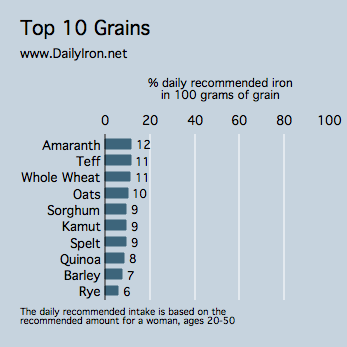 Grains are a great comfort food in pregnancy and many women palate grains very easily. The bran of the grain tends to be highest in iron, but the bran is also highest in an iron inhibitor called phytic acid. Alternative grains such as quinoa, teff, and amaranth are high in iron as well but also do have phytic acid. Enjoy grains in your pregnancy diet but if you rely on them for iron, you must read our tips and tricks page to increase your absorption of their iron content.
Grains are a great comfort food in pregnancy and many women palate grains very easily. The bran of the grain tends to be highest in iron, but the bran is also highest in an iron inhibitor called phytic acid. Alternative grains such as quinoa, teff, and amaranth are high in iron as well but also do have phytic acid. Enjoy grains in your pregnancy diet but if you rely on them for iron, you must read our tips and tricks page to increase your absorption of their iron content.
Beans
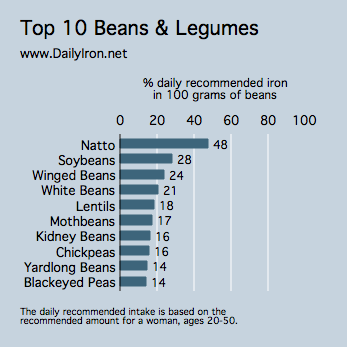 Beans are also high in iron but, like grains, they do contain phytic acid and that phytic acid will keep your from absorbing much of the iron in the beans. In fact, at the top of the list is soybeans and soybeans are notoriously high in phytic acid. Worse yet, you can soak and soak those soybeans and never reduce the phytic acid content. Fermented soy such as miso or tempeh is your best bet.
Beans are also high in iron but, like grains, they do contain phytic acid and that phytic acid will keep your from absorbing much of the iron in the beans. In fact, at the top of the list is soybeans and soybeans are notoriously high in phytic acid. Worse yet, you can soak and soak those soybeans and never reduce the phytic acid content. Fermented soy such as miso or tempeh is your best bet.
Nuts And Seeds
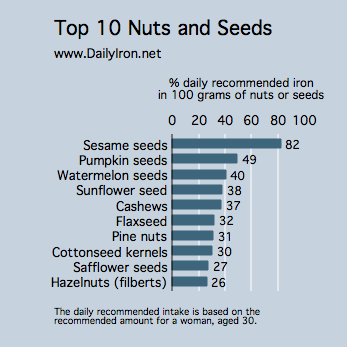 Nuts and seeds can be a great pregnancy snack but they do contain phytic acid as well. For the most part, we recommend soaking your nuts and seeds to reduce the phytic acid content, a process that is somewhat effective. It is probably best to rely on a combination of food for iron, not just on nuts and seeds. You can often find artisan sourdough breads that include nut flours. These may be good, creative options for you since a sourdough preparation does reduce the iron inhibitors in the nut flours.
Nuts and seeds can be a great pregnancy snack but they do contain phytic acid as well. For the most part, we recommend soaking your nuts and seeds to reduce the phytic acid content, a process that is somewhat effective. It is probably best to rely on a combination of food for iron, not just on nuts and seeds. You can often find artisan sourdough breads that include nut flours. These may be good, creative options for you since a sourdough preparation does reduce the iron inhibitors in the nut flours.
Vegetables
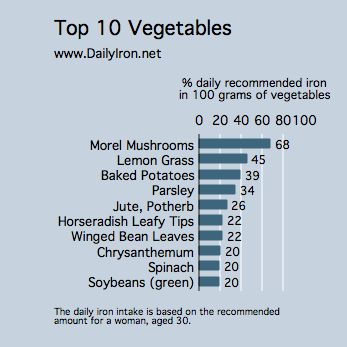 Vegetables as a class are generally a poor source of iron; there really are no high iron vegetables. In fact, from our food list, you would have to eat large quantities of those vegetables to pack a punch. For vegetables, focus on those that are high in vitamin C, such as tomatoes and bell pepper. The vitamin C in the vegetables will actually help your body absorb more iron in your grains, legumes, nuts, and seeds, making them great supporters of an iron-rich pregnancy.
Vegetables as a class are generally a poor source of iron; there really are no high iron vegetables. In fact, from our food list, you would have to eat large quantities of those vegetables to pack a punch. For vegetables, focus on those that are high in vitamin C, such as tomatoes and bell pepper. The vitamin C in the vegetables will actually help your body absorb more iron in your grains, legumes, nuts, and seeds, making them great supporters of an iron-rich pregnancy.
Fruits
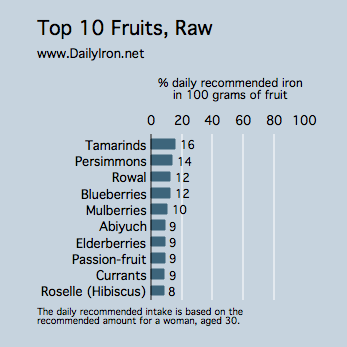 Like vegetables, there really are no iron rich fruits, but fruits tend to be high in vitamin C content and can play an important role in iron metabolism as a result. If you have little or no meat in your diet, high vitamin C fruit will be an important strategy for you to improve your iron absorption.
Like vegetables, there really are no iron rich fruits, but fruits tend to be high in vitamin C content and can play an important role in iron metabolism as a result. If you have little or no meat in your diet, high vitamin C fruit will be an important strategy for you to improve your iron absorption.
Pregnancy is a tough time and you need to find a meal plan that works for you and your family. Explore the resources here, consider what you can actually palate, and put together a creative high iron diet.
